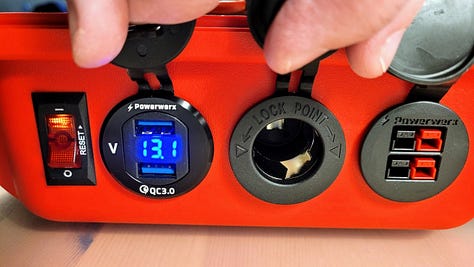Portable power and physical comparison of antennas
A Powerwerx box for the truck and a size comparison of two half-wave antennas
Portable power
My new truck (Honda Ridgeline) has a feature that I have been cursing. To save fuel, the engine shuts off when the vehicle is stopped at a traffic light. However, when the engine shuts off, power to the 12-volt adapter in the cab of the truck is also interrupted. (Yes, I’m powering the Kenwood TM-D710GA radio from the 12V plug, because I move the radio between several vehicles. When the power cycles, the radio also shuts off. It’s a bit disconcerting every time I see and hear the radio power cycle.)
I’ve listened to many episodes of the Ham Radio Workbench podcast where portable power packs have been discussed. Over time, a small lightbulb finally flickered into existence in my brain: use a power pack in the truck to power the radio instead of running it directly from the 12V adapter. That would solve the issue with the truck shutting off to save fuel, plus it gives me a way to power the radio if the truck battery dies or portable power for Parks On The Air activations. I already have Powerpole adapters for my HF radios, so a portable power pack with Powerpoles makes sense to me.
(Being located most of the time near Portland, Oregon, I’m only 15-20 minutes from a Ham Radio Outlet store. There are moments when I think some of us who enjoy amateur radio might benefit from our own 12-step program. “Hi, my name is Tom, and I have too many radios.”)
Ham Radio Outlet has the Powerwerx PWRbox 15 on sale, $20 off. I picked one up today.
Here are the unboxing photos:









The unit came with the battery already charged to 13.1 volts. Charging is via the Powerpoles and the circuit breaker/switch must be on to charge the battery.
I’ll dig up a few spare fuses and stash them in the case, just in case.
I’d like to keep it charged using 12V power from the truck but the charging voltage should be 14.6V. To solve this, I expect that I’ll purchase a solution from Powerwerx. They have a DC-to-DC charger that should work with the PWRbox-15 charged in the vehicle. It is adjustable down to 2 amps which is the output of the charger supplied with the PWRbox-15. See Powerwerx DCDC-8A 14.5V, 8A Adjustable DC-to-DC Battery Charger for 12V LiFePO4 Batteries for more about this unit.
Comparison: two dual-band mobile antennas
As an addendum to the previous post (Diamond NR770HB antenna on two different mounts), I glanced through the Comet antennas hanging on the wall at the Ham Radio Outlet store. A Comet SS680SB antenna was staring back at me, practically begging to be taken home (see the third paragraph in this post about a 12-step program for amateur radio enthusiasts).
It is happily residing on top of the truck. Physically, it is remarkably different than the Diamond NR770HB antenna. While both are half-wave antennas on 2 meters, they look nothing alike. The Comet antenna is made of slimmer, more flexible wire, and it has a stiff spring at the base to protect it from people who smack their antenna into tree branches and other obstructions…like me.
Says Comet:
Specially designed dualband 2M/440MHz mobile antennas with a spring base to absorb brushes with tree limbs, flying debris, garage doors, etc… No antenna is indestructible, but the spring will help keep the antenna from breaking in most cases.
The Comet antenna is a svelte 27 inches tall, significantly shorter than the Diamond antenna at 40.2 inches. In comparison, the Diamond antenna is a stout beast.
No more whacking the tall Diamond antenna on the carport roof or at a drive-through because I forgot to stop and flip it over. Even though I really like the Diamond antenna, I expect that the more practical Comet antenna will be my go-to for the foreseeable future.




